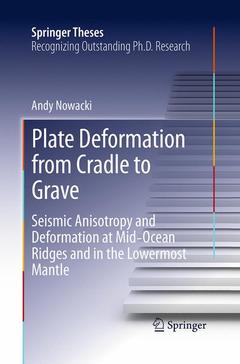Description
Plate Deformation from Cradle to Grave, Softcover reprint of the original 1st ed. 2013
Seismic Anisotropy and Deformation at Mid-Ocean Ridges and in the Lowermost Mantle
Springer Theses Series
Language: English
Plate Deformation from Cradle to Grave
Publication date: 08-2016
Support: Print on demand
Publication date: 08-2016
Support: Print on demand
Plate Deformation from Cradle to Grave
Publication date: 12-2012
166 p. · 15.5x23.5 cm · Hardback
Publication date: 12-2012
166 p. · 15.5x23.5 cm · Hardback
Description
/li>Contents
/li>Biography
/li>Comment
/li>
The Earth's rocky mantle convects to lose heat, which comes from the liquid iron core below. The mantle's interfaces - the core-mantle boundary, and the lithosphere - may hold the key to understanding mantle motion because of the seismic anisotropy present in these parts of the Earth.
In this thesis, Andy Nowacki presents a precise but comprehensive review of the current state of the art in studying flow with anisotropy, mineral physics and geodynamics. New measurements of shear wave anisotropy in the lowermost mantle and at mid-ocean ridges are used to constrain mechanisms of creep and melt extraction in the mantle. A model of global flow is used to predict anisotropy in the deep Earth, and novel methods to forward model shear wave splitting are described. Future studies of mantle flow must incorporate the understanding gained in this thesis.
The thesis contains a substantive introduction to the structure of the Earth, seismic anisotropy in general and in the core-mantle boundary region, and mid-ocean ridge processes. It also describes novel methods for forward modelling and interpreting shear wave splitting data. Three chapters present timely research into dynamics at divergent plate boundaries and at the core-mantle boundary.
In this thesis, Andy Nowacki presents a precise but comprehensive review of the current state of the art in studying flow with anisotropy, mineral physics and geodynamics. New measurements of shear wave anisotropy in the lowermost mantle and at mid-ocean ridges are used to constrain mechanisms of creep and melt extraction in the mantle. A model of global flow is used to predict anisotropy in the deep Earth, and novel methods to forward model shear wave splitting are described. Future studies of mantle flow must incorporate the understanding gained in this thesis.
The thesis contains a substantive introduction to the structure of the Earth, seismic anisotropy in general and in the core-mantle boundary region, and mid-ocean ridge processes. It also describes novel methods for forward modelling and interpreting shear wave splitting data. Three chapters present timely research into dynamics at divergent plate boundaries and at the core-mantle boundary.
Seismic anisotropy and deformation in the lowermost mantle.- Mantle anisotropy beneath the Earth’s mid-ocean ridges.- Deformation of the lowermost mantle from seismic anisotropy.- Predicting lowermost mantle anisotropy using models of mantle flow.
Andy Nowacki is currently a seismologist at the University of Bristol whose recent research has focussed on using seismic anisotropy to study the dynamics of the lowermost and uppermost mantles. Incorporating mineral physics, geodynamics and seismic wave propagation, he has attempted to integrate recent advances in geophysics to better understand the Earth's mantle. Other interests include microseismicity at divergent plate boundaries and volcano seismology.
Outstanding doctoral thesis nominated for a Springer Theses Prize by the University of Bristol, United Kingdom A comprehensive explanation of seismic anisotropy in the lowermost mantle gives the reader a clear but full picture of the state of understanding of the core-mantle boundary Several novel methods for the modeling and interpretation of shear wave splitting are described, giving the reader a set of tools for their own analyses Over 50 high-quality figures, about half in colour, succinctly present the background knowledge in the field alongside novel results, serving as a useful leaning aid for students or teachers of seismology Includes supplementary material: sn.pub/extras
© 2024 LAVOISIER S.A.S.




